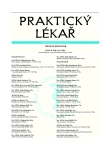-
Medical journals
- Career
Trace elements and bone
Authors: I. Žofková 1; P. Němčíková 2
Authors‘ workplace: Endokrinologický ústav, Praha Ředitel: doc. MUDr. Vojtěch Hainer, CSc. 1; 3. lékařská fakulta UK, Praha Děkan: prof. MUDr. Michal Anděl, CSc. 2
Published in: Prakt. Lék. 2010; 90(11): 646-648
Category: Various Specialization
Overview
The trace elements modulate many physiologic functions and have doubtless importance for the development of bone in foetal period, childhood and adolescence, as well as for integrity of the adult skeleton. Some of them have an osteoprotective effect (zinc), while others are toxic (cadmium, chromium, cobalt). Measurement of trace element concentrations in body fluids (blood and urine) or in tissues (hairs and bone) enables us to identify subjects at risk of osteoporotic fractures as a consequence of nutrition deficiency. The article reviews the current understanding of the role of trace elements in bone physiology.
Key words:
bone, copper, zinc, boron, fluor, magnesium, manganese, cobalt, chromium, cadmium.
Sources
1. Akesson, A., Bjellerup, P., Lundh, T. et al. Cadmium-induced effects on bone in a population-based study od women. Environ. Health Perspect. 2006, 114, p. 830-834.
2. Azpeitia-Valadez, Mde, Rodríguez-Frausto, M., Sánchez-Hernández, M.A. Prevalence of dental fluorosis in children between 6 - 15 years old. Rev. Med. Inst. Mex. Seguro. Soc. 2008, 46, p. 67-72.
3. Atik, O.S., Uslu, M.M., Eksioglu, F., Satana, T. Etiology of senile osteoporosis. A hypothesis. Clin. Orthopaed. Related. Res. 2006, 443, p. 25-27.
4. Devirian, T.A., Volpe, S.L. The physiological effects of dietary boron. Critical Rev. Food. Sci. Nutr. 2003, 43, p. 219-231.
5. Kanazawa, I., Yamamoto, M., Yamaguchi, T.Z. et al. A case of magnesium deficiency associated with insufficient parathyroid hormone action and severe osteoporosis. Endocr. J. 2007, 54, p. 935-940.
6. Maverakis, E., Fung, M.A., Lunch, P.J. et al. Acrodermatitis enteropathica and an overview of zinc metabolism. J. Am. Acad. Dermatos. 2007, 56, p. 116-124.
7. Mutlu, M., Argun, M., Kilic, E. et al. Magnesium, zinc and copper status in osteoporotic, osteopenic and normal post-menopausal women. J. Int. Med. Res. 2007, 35, p. 692-695.
8. Němčíková, P., Spěváčková V., Čejchanová, M., Hill, M., Žofková, I. Vztah sérových hladin manganu a mědi k denzitě a kvalitě kosti u postmenopauzálních žen. Pilotní studie. Osteologický bulletin 2009, 14, s. 97-100.
9. Parelman, M., Stoecker, B., Baker, A., Madeiros, D. Iron restriction negatively affects bone in female rats and mineralization of hFOB osteoblast cells. Exp. Biol. Med. (Maywood) 2006, 231, p. 378-386.
10. Rico, H., Gómez-Raso, N., Sevilla, M. et al. Effects on bone loss of manganese alone or with copper supplement in ovariectomized rats. A morphometric and denzitometric study. Eur. J. Obstet. Gynecol. Reprod. Biol. 2000, 90, p. 97-101.
11. Žofková I., Němčíková P. Stopové prvky a jejich vztah ke kostnímu metabolismu. Diabetologie, metabolismus, endokrinologie, výživa 2008, 4, s. 172-176.
Labels
General practitioner for children and adolescents General practitioner for adults
Article was published inGeneral Practitioner

2010 Issue 11-
All articles in this issue
-
Evoluce a evoluční teorie pro lékaře
XI. Vývoj jazyka - Testosterone and lifestyle diseases
- Antiaggregation and gastroprotective drugs
- Trace elements and bone
- Current understanding of rhinosinusitis or familiarization with the European consensus on rhinosinusitis and nasal polyposis (EP3OS)
- Treatment of hypertensive patients in ambulatory care in Slovakia
- Advance directives of patients and perception of this problem in the Czech republic and Germany
- Patients with Benign Prostatic Hyperplasia: Proportional representation of treatment procedures
- Alcohol, tobacco, drugs and reproductive risks
- Bronchial asthma and allergic rhinitis in employees in the manufacture of homemade dumplings
-
Evoluce a evoluční teorie pro lékaře
- General Practitioner
- Journal archive
- Current issue
- Online only
- About the journal
Most read in this issue- Antiaggregation and gastroprotective drugs
- Testosterone and lifestyle diseases
- Trace elements and bone
- Alcohol, tobacco, drugs and reproductive risks
Login#ADS_BOTTOM_SCRIPTS#Forgotten passwordEnter the email address that you registered with. We will send you instructions on how to set a new password.
- Career

